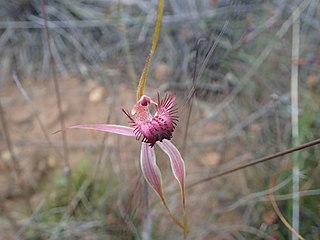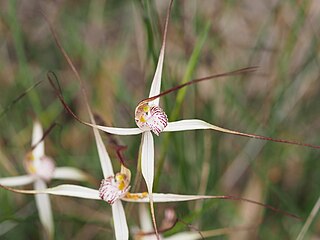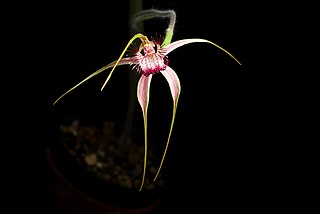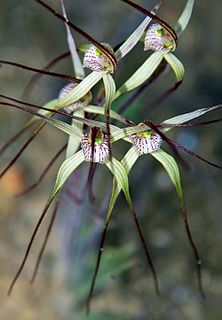
Caladenia dimidia, commonly known as the chameleon orchid is a species of orchid endemic to the south-west of Western Australia. It has a single hairy leaf and one or two yellow, cream-coloured or pinkish flowers. It is a variable species, similar to the Joseph's spider orchid but has a more northerly distribution and smaller flowers.

Caladenia attingens, commonly known as mantis orchids, are plants in the orchid family Orchidaceae and are endemic to the south-west of Western Australia. There are three subspecies, each of which has a single hairy leaf and one or two brightly coloured flowers with upswept sepals and a labellum with long, comb-like fringes. The subspecies differ in size, distribution and habitat.
Caladenia bicalliata subsp. bicalliata, commonly known as the limestone spider orchid or dwarf limestone spider orchid, is a plant in the orchid family Orchidaceae and is native to the south-west of Western Australia and coastal areas of South Australia. It has a single erect, hairy leaf and one or two cream-coloured flowers with reddish-brown tips.
Caladenia bicalliata subsp. cleistogama, commonly known as the shy limestone spider orchid or sandhill spider orchid, is a plant in the orchid family Orchidaceae and is native to the south-west of Western Australia. It has a single erect, hairy leaf and one or two cream-coloured flowers which are smaller than those in subspecies bacalliata.
Caladenia bicalliata is a plant in the orchid family Orchidaceae and is native to the south-west of Western Australia and coastal areas of South Australia. It has a single erect, hairy leaf and one or two cream-coloured flowers. There are two subspecies differing in the size and colour of the flowers.

Caladenia decora, commonly known as the Esperance king spider orchid is a species of orchid endemic to the south-west of Western Australia. It has a single hairy leaf and up to three red, yellow and green flowers. It is a variable species, similar to the king spider orchid and sometimes hybridises with other species so that it can be difficult to recognise, but is one of the largest spider orchids found in Western Australia.

Caladenia denticulata subsp. denticulata, commonly known as the yellow spider orchid, is a plant in the orchid family Orchidaceae and is endemic to the south-west of Western Australia. It has a single erect, hairy leaf and one or two yellowish flowers which have a white labellum with pale red markings.
Caladenia denticulata subsp. albicans, commonly known as the alabaster spider orchid, is a plant in the orchid family Orchidaceae and is endemic to the south-west of Western Australia. It has a single erect, hairy leaf and one or two pale creamy-white flowers which have a white labellum with red markings. The only known population occurs in a small area near Arrowsmith.
Caladenia denticulata subsp. rubella, commonly known as the clumped spider orchid, is a plant in the orchid family Orchidaceae and is endemic to the south-west of Western Australia. It has a single erect, hairy leaf and one or two dull or pinkish red flowers with prominent dull red markings and with a white labellum with red markings.

Caladenia erythronema, commonly known as the red thread spider orchid, and Nyabing spider orchid is a plant in the orchid family Orchidaceae and is endemic to the south-west of Western Australia. It has a single hairy leaf and up to three red, yellow or cream-coloured flowers with dangling, thread-like sepals and petals and a small labellum.
Caladenia hiemalis, commonly known as the dwarf common spider orchid is a species of orchid endemic to the south-west of Western Australia. It has a single, hairy leaf and one or two, cream-coloured flowers with a small, red-striped labellum. It has an early flowering period and its flowering is stimulated by summer fires.

Caladenia horistes, commonly known as the cream spider orchid is a species of orchid endemic to the south-west of Western Australia. It has a single, hairy leaf and one or two, creamy-yellow flowers which have a red-striped labellum and long, dark, thread-like tips on the sepals and petals.

Caladenia longicauda subsp. rigidula, commonly known as the rigid white spider orchid or island white spider orchid, is a plant in the orchid family Orchidaceae and is endemic to the south-west of Western Australia. It has a single hairy leaf and up to three large, mainly white flowers with relatively short lateral sepals and petals. It is similar to the reclining white spider orchid but that species has smaller, cream-coloured flowers.

Caladenia multiclavia, commonly known as the lazy spider orchid is a species of orchid, endemic to the south-west of Western Australia. It has a single, hairy leaf and one or two greenish-yellow, red and cream-coloured flowers resembling a reclining spider. Although it usually only has a single flower, it often grows in clumps of up to six plants.

Caladenia pendens subsp. pendens, commonly known as the pendant spider orchid, is a plant in the orchid family Orchidaceae and is endemic to the south-west of Western Australia. It has a single hairy leaf and up to three relatively large, creamy-white flowers with long drooping petals and sepals and sometimes has a sickly-sweet scent.
Caladenia pholcoidea subsp. pholcoidea, commonly known as the Albany spider orchid, is a plant in the orchid family Orchidaceae and is endemic to the south-west of Western Australia. It has a single hairy leaf and up to four pale yellow flowers with long drooping petals and lateral sepals.

Caladenia polychroma, commonly known as the Joseph's spider orchid, is a species of orchid endemic to the south-west of Western Australia. It has a single erect, hairy leaf and one or two relatively large and colourful but smelly flowers.

Caladenia serotina, commonly known as the Christmas spider orchid, is a species of orchid endemic to the south-west of Western Australia. It has a single erect, hairy leaf and up to three white to cream-coloured and red flowers, although the relative amount of each is variable. It is one of the later-flowering spider orchids and occurs in the far south-west corner of the state.

Caladenia splendens, commonly known as the splendid spider orchid, or splendid white spider orchid is a species of orchid endemic to the south-west of Western Australia. It has a single erect, hairy leaf and up to three mostly white flowers with a fringe of long teeth on the sides of the labellum. Along with the giant spider orchid, Caladenia excelsa it is the largest of the spider orchids.

Caladenia vulgata, commonly known as the common spider orchid, is a species of orchid endemic to the south-west of Western Australia. It is a relatively common and widespread orchid with a single erect, hairy leaf and up to three creamy-white flowers. There is some variation in the species, both in flower colour and growth habit.













